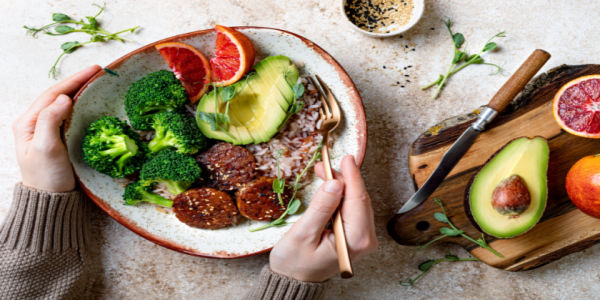
If you’re wondering how to eat healthy when you hate vegetables, you aren’t alone. Many people have trouble choking down Brussels sprouts and leafy greens. While fruits and vegetables are heralded for helping to prevent conditions like heart disease, you can still learn how to eat healthy when you don’t like vegetables.
Keep reading for how to eat healthy if you hate vegetables, including five foolproof tricks to try.
How to Eat Healthy When You Don’t Like Vegetables
Most people know that eating more fruits and veggies is a great way to stay healthy. However, a bitter flavor or lack of familiarity with certain pieces of produce can lead to a lack of desire to eat more vegetables.
1. Choose Complex Carbohydrates
Carbohydrates—or simply carbs—sometimes get a bad rap. However, the body needs carbs for energy and to carry on its normal functions. Complex carbs contain a higher level of nutrients than simple carbohydrates, taking longer for the body to digest, and also help to keep blood sugar levels balanced.
Some complex carbohydrates that aren’t vegetables include:
• Legumes (i.e. peas, beans)
• Nuts and seeds
• Whole grains (i.e. oats, quinoa, barley)
Sweet potatoes, a type of vegetable with a sweeter taste than regular potatoes, contain some complex carbs as well. If you’re feeling adventurous, you can prepare sweet potatoes almost any way you would prepare a normal potato.
Since potatoes are starchy, even people who don’t normally like vegetables can often find a way to enjoy them.
2. Keep It Lean With Protein
Just like carbohydrates, not all proteins are created equal. Lean proteins provide the body with much needed nutrients but keep saturated fats low.
Choose from the following food options for a healthy source of lean protein:
• Fish or seafood (i.e. cod, salmon, tuna)
• Lean cuts of meat (i.e. beef, goat, lamb, pork)
• Legumes (i.e. lentils, soy)
• Low-fat dairy (i.e. cheese, cottage cheese, yogurt)
• Nuts and seeds (i.e. almonds, chia seeds, peanuts)
• Skinless poultry (i.e. chicken, duck, turkey, quail)
3. Add Healthy Fats for Appetite
Like carbohydrates, fats are often vilified However, healthy dietary fats are key to maintaining optimal health. Omega-3 fatty acids in particular are known for offering health benefits.
The following foods can add healthy fats to your diet:
• Avocado
• Eggs
• Nuts, nut butters, and seeds (i.e. peanut butter, walnuts)
• Olive oil
• Seeds (i.e. flaxseed, hemp seeds)
If you do choose to add vegetables to your diet, tossing them in olive oil and seasonings can make them much more appetizing than if they are consumed plain. Healthy fats can help keep you feeling full and make vegetables and other foods more satiating.
4. Avoid Added Ingredients
Breaded, fried, or ultra-processed foods may not make the healthiest options (even if vegetables are hidden underneath). Added ingredients often reduce the nutrient quality of a food or beverage. Especially if you aren’t keen on fruits or vegetables, it’s important to learn how to read the label and select nutrient-rich foods.
Avoid the following foods or ingredients when possible:
• Added salt
• Added sugar
• Saturated and trans fats
5. Try Something New
Throwing out an entire food group isn’t always in your best interests. Instead of cutting out vegetables altogether, consider cooking veggies in a new and exciting way. This can make them more appetizing, and you may even find a new favorite.
Try the following cooking methods to switch it up:
• Roasted vegetables
• Sheet pan meals
• Stir-fry
Vegetables can also be appetizing in unexpected forms. For example, cauliflower can be turned into cauliflower rice with a food processor and then used as a substitute for rice in meals. In fact, cauliflower has even been used to make pizza crust.
Seasonings beyond salt and pepper can also spice a meal up. Try homemade seasoning blends or make-your-own spice mixes.
Don’t know where to start? There are so many foods and flavor combinations you can try with bistroMD. Ordering meal delivery in a busy season of life can help inspire you when you have more time to make homemade meals down the road.
The Bottom Line on Eating Healthy When You Hate Vegetables
The old adage “eat your veggies” can seem like quite the challenge for some people. Luckily, there are plenty of nutrient-rich foods you can add to your diet to keep it well-balanced.
Learning which foods have more nutrients than others can help you make smart and delicious decisions.
References:
Ellis E, Msora-Kasago C, Derocha G, Bochi RA, Escobar S, Sheth V. How Much Protein Should I Eat? Eatright.org. Published December 2020.
Gordon B. Choose Healthy Fats. Eatright.org. Published August 2019.
Gunnars K. Carbohydrates: While vs. Refined — Here’s the Difference. Healthline.com. Published July 2021.
Scott-Dixon K. Sweet vs. regular potatoes. Precisionnutrition.com. Accessed 2022.
Younkin L. What Is a Complex Carbohydrate? Eatingwell.com. Published November 2017.






